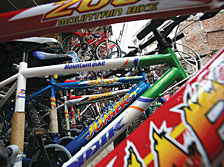 ALL PICS: KIRAN PANDAY |
Chances are your car or motorcycle will grind to a halt midway, its fuel finished. Or last night's load-shedding will have left your electric bike in a coma. If walking is not an option, you're left with the humble pedal cycle.
It may be simple technology, but with no end in sight to the fuel crisis, more and more people in the city are seeing the advantages of cycling.
 PEDAL POWER: Surabhi Pudasaini |
Fellow traveller David Kraklau takes to the road with his bicycle whenever he can. "They're the perfect transport for a place like Kathmandu, especially in Ason and Mangal Bajar," he says.
Bicycle sales may not be as high as in the days before people could afford cars, but retailers say they have seen a significant increase in the past two years. Even upwardly mobile office workers are buying them, though few use them all the time. Petrol may now be as rare as a bottlenose dolphin in the Karnali, but there is clearly no shortage of petrol-burning vehicles waiting for their rations.
 David Kraklau see the benefits of cycling |
 |
"We are working on them," Tulasi Prasad Sitaula, the department's director-general assured us. "But our priority is the main roads." And the cycle paths are not linked together, so they won't make long-distance cycling through the city any easier.
 volunteer Amanda Talbot attends a VSO Nepal rally to promote cycling in the city. |
Anywhere inside the ring road is in easy riding distance. "But some people are just lazy," says Kraklau. "They'll take their car even if work is just a kilometre away."
They may be better for the environment and for people's health, but not everyone wants to see more bicycles on the streets.
"If everyone used cycles, the rate of work done would be slower and our economy would collapse," says Laxman Ratna Tuladhar, director of Hero Honda Motorcycles in Nepal. "What we need most is a means of mass transportation."
Tuladhar believes the future is in electric vehicles, and says Nepal should be using its hydropower resources to become a leader in sustainably-powered electric vehicles instead of relying on petrol imports.


